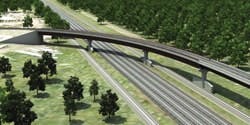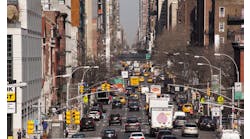By: Peter Gertler
The lack of a reliable funding source has forced America’s high-speed rail program to evolve and mature into a more incremental approach.
The $10 billion federal investment, appropriated between 2009 and 2012, is the only federal investment so far, and the industry, never thinking Congress would abandon the sizeable down payment, has had to adjust its goals to reflect the constrained fiscal environment.
Lawmakers recognize the value high-speed rail could add to improve our mobility and environment, while being a stimulus for jobs and economic growth; they just cannot figure out how to raise more revenue to pay for it. The uncertainty has caused programs from California to the Northeast to prioritize and focus their initial investments on creating the greatest value as soon as possible and to provide the best foundation for future investment.
That new approach includes addressing the first-mile-last-mile problem. Part of the maturing of the high-speed rail vision is realizing we cannot simply build a high-speed rail system and call it good. We also must build and improve commuter and inner-city rail systems that will feed it. The mature vision focuses on the entire system, not just the high-speed rail piece.
Understandably, people are curious, as well as skeptical. The industry’s more conservative approach has raised questions, with some of the main concerns addressed below:
Can the U.S. afford high-speed rail?
According to the American Public Transportation Association, a U.S. high-speed rail system can generate a net benefit of at least $660 million annually. Over the next four decades, we stand to gain at least $26.4 billion in mobility, jobs, urban renewal, environmental benefits and other economic paybacks.
Opponents insist that cash-strapped states and a debt-ridden federal government cannot afford high-speed rail’s massive price tag. No doubt funding is an issue. Building a high-speed rail system on an installment plan is not an optimal way to develop a new transportation mode, but that is how the interstate highway system was built. Back then, no one knew where all the money would come from. Thankfully, they did not scrap the idea.
For now, it is likely high-speed rail will be funded by a combination of federal funding, public-private investment and borrowed money.
Opponents will say there is strong opposition to raising taxes to pay for transportation infrastructure, including high-speed rail.
Beware of blanket statements about what America prefers. Last year, in California, voters approved a $2.7 billion bond measure to fund high-speed rail. People will approve spending when they know the money will stay in their communities, and they will benefit from it.
California is indicative of states taking greater responsibility to fund their own programs through alternative, innovative sources. Denver’s Regional Transportation District is planning to use public-private partners to implement many of its FasTracks projects, including Denver Union Station, North Metro and I-225 Rail Lines, as well as the East Rail Line, Gold Line and commuter rail maintenance facility projects.
The Oakland Airport Connector, another public-private partnership (P3) project, would provide a high-quality link between the Bay Area Rapid Transit’s regional rail system and the Oakland International Airport, using a direct and exclusive aerial guideway for transit vehicles, departing to and from the existing Coliseum BART Station.
And, although plans to privatize the Northeast Corridor are only being discussed and not implemented, according to Streetsblog Capitol Hill, there seems to be general consensus that the private sector has a place in rail development and the federal government needs to do more to encourage such investment.
Will high-speed rail be self-sustaining?
Some believe high-speed rail will not be self-sustaining and, therefore, will be unworthy of taxpayer dollars. Even if that were true, should that be the yardstick by which we measure the value and success of vital alternative modes of transportation? Our highway, maritime and aviation systems are not self-sustaining, but they are extremely valuable in helping the U.S. achieve its transportation goals. One of those goals should be to prioritize high-speed rail, so if gasoline prices go even higher and airline fares rise in response, the traveling public will have somewhere to turn for 200- to 600-mile trips.
Is it realistic to expect federal support?
In April, President Obama announced the National High Performance Rail System (NHPRS) as part of his FY 2014 budget. The major new initiative would receive $40 billion invested over the next five years in the following way:
- A new Current Passenger Rail Service Program (CPRSP), receiving $13.2 billion to replace the existing Amtrak rail grant funding structure;
- A new Rail Service Improvement Program (RSIP), receiving $26.4 billion to develop new passenger rail corridors and expand and improve existing corridors; and
- Research, development and technology, receiving $217 million.
Some say the NHPRS is President Obama’s outline for the next Passenger Rail Investment and Improvement Act (PRIIA) reauthorization, which expires later this year.
Obama also is proposing an additional $50 billion to jump-start infrastructure investment, with another $3 billion for the RSIP and $2 billion for the CPRS, bringing the total Federal Rail Administration (FRA) 2014 fiscal-year request to $11.6 billion.
Clearly, there is no commitment or even consensus that these funds should be or will be authorized, but they certainly give a basis for a conversation about future federal support and how to raise revenues to support future funding.
Why have some regions succeeded in advancing high-speed rail while others have failed?
Heavy urban congestion and high gas prices are contributing factors, but the key to moving high-speed rail forward is having a proactive governor.
California’s high-speed rail program came close to death many times, but overwhelming support from former Gov. Arnold Schwarzenegger and current Gov. Jerry Brown kept it alive. If a state’s high-speed rail program does not have a political champion at the highest level, the probability of it surviving is unlikely.
Likewise in the Northeast Corridor, there has been almost unanimous support at the federal and state levels, and the investment to improve speed, reliability and safety in one of the world’s busiest and most productive travel corridors must continue and grow.
However, there is more to high-speed rail’s feasibility than political willpower. Certain economic conditions must exist, such as:
- Dense urban areas with significant population growth projections;
- Major cities spaced 200 to 600 miles apart;
- Paralyzing congestion at airports and on interstates;
- Environmentally conscious citizens who want greener transportation options; and
- Multimodal-friendly cities with transit and light-rail systems that can feed the high-speed rail system, solving the first-mile-last-mile problem.
Can high-speed rail create U.S. jobs?
The tangible economic benefits, which the industry has been predicting for the past five years, now are surfacing, which could help garner Congressional support for PRIIA’s reauthorization. We are seeing the fruits of high-speed rail investment in places such as the Midwest, where 460 companies are poised to contribute to the rail supply chain and modernize passenger rail in America, according to a February 2013 article posted on EV(Electric Vehicle)world.com.
The article cites a report from the Environmental Law and Policy Center, stating the $782 million being invested in building 33 quick-acceleration locomotives and 130 passenger cars “is the pinnacle of a large supply chain, creating jobs and economic development in diverse industries across the country.
The federal ‘Buy America’ standard will ensure that the resulting job growth will happen mostly in the United States.”
The report goes on to say several of today’s rail-manufacturing plants are “once-shuttered automobile suppliers that have retooled to seize the opportunities rail investment has created.”
The fact is jobs associated with developing, operating and manufacturing high-speed rail are prime U.S.-based jobs that will not be off-shored.
Will high-speed rail spark urban renewal or promote sprawl?
Unlike many airports, located miles from dense urban areas, train stations can be planted in the heart of a city’s downtown, becoming magnets for commercial and residential development. We do not have to wait for high-speed rail to become a reality to prove the concept. We have seen light rail and commuter rail stations spark transit-oriented development across the country. Where there is access to transportation, there is economic growth.
Something else to consider: A study conducted by the University of California Los Angeles and China’s Tsinghua University suggested when second-tier cities, such as St. Louis, are linked by high-speed rail to global hubs, such as Chicago, people will migrate to the second-tier city, causing a housing boom.
In China, high-speed trains boosted market potential by 10% and housing pricings by 4.5%. Researchers believe the same could happen in the U.S. if high-speed rail connects smaller cities to larger ones.
Well on its way and not turning back
Constituents will see real high-speed rail progress—in terms of quality of life, job creation and economic growth—in the next three to five years as the U.S. economy begins to turn around. Once Americans reap the benefits—instead of just hearing about them—the financial support necessary to move this new mode forward should come easier.
For now, although there is no clear path to a secure, sustainable funding source, work is being done. As former U.S. Secretary of Transportation Ray LaHood said before he retired this past January, high-speed rail is “well on its way and not turning back.”
About The Author: Gertler is chair of high-speed rail services at HNTB Corp.



